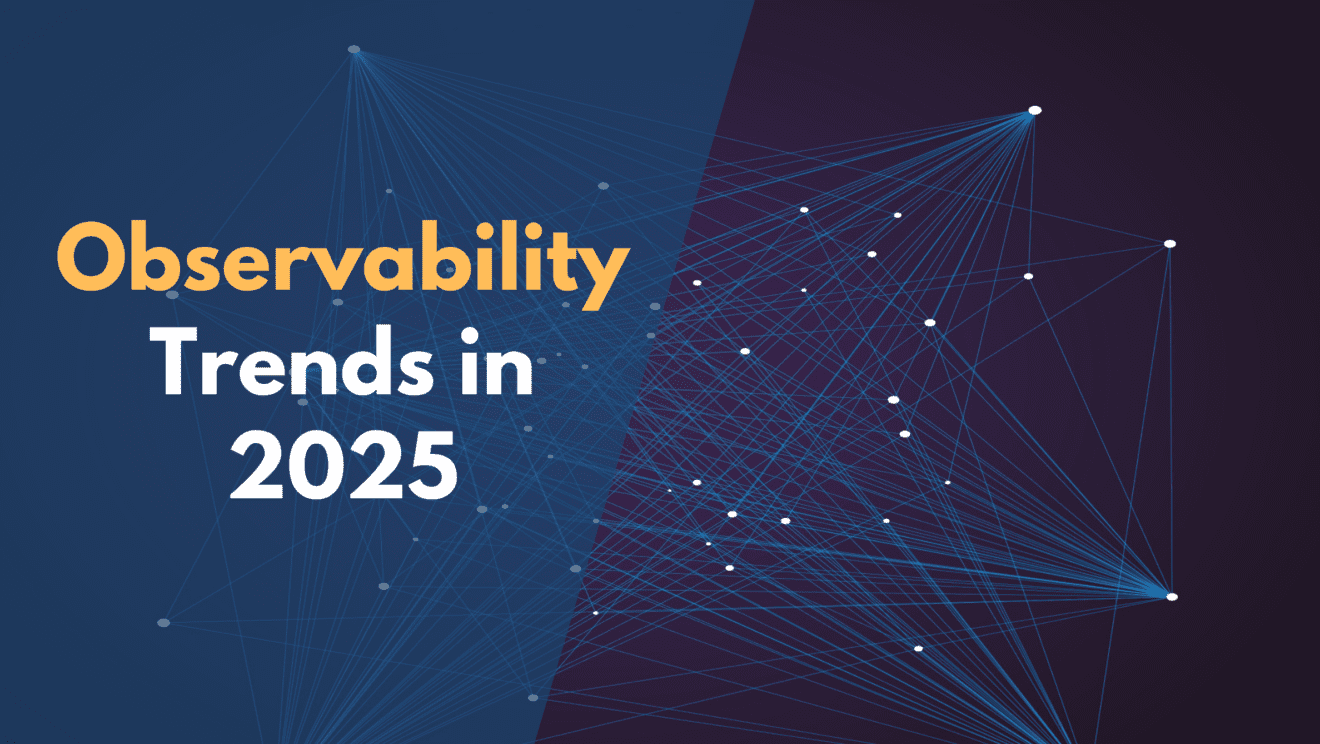Every year, new trends and patterns emerge in the observability world. Some recur, and some develop with the changing data and technology landscape. Observability in 2025 is being reshaped in many ways. From proactive AI observability to data management prioritization, the current state of observability is evolving fast.
For instance, AI observability has been a recurring trend for the last 3-4 years. And looking at its development in 2025, it’s here to stay for the coming years. Besides this, other major noteworthy shifts include smarter data management practices, observability 2.0, widespread open-source adoption, etc.
In this blog, we’ll zero in on the top 5 observability trends for 2025, their implications on observability in software, and why you should adopt them in your observability strategy.
- AI-Powered Proactive Observability
Nearly 65% of organizations plan to increase their investments in AI-driven data processes by 2025, according to Gartner’s 2024 CIO Survey.
Traditional monitoring is giving way to automation. Enterprises today are dealing with an unprecedented volume of data from complex tech stacks and multi-cloud environments. Thus, manual operations simply can’t keep up, making intelligent monitoring and automation crucial for modern observability platforms.
It’s because monitoring often catches issues after a disruption. AI-powered systems, on the other hand, take a proactive approach to anomaly detection. They analyze your system’s performance data to detect patterns and predict imminent failures.
A proactive approach prevents potential downtime, saves resources, and builds an overall enhanced observability environment.
Such efficiencies pave the way for unified observability with artificial intelligence, data management, security, and business analytics as pieces of the puzzle. As a result, enterprises are shifting from siloed AI observability tools to comprehensive platforms like Apica.
- Data Management Prioritization
Data observability has a problem – adopting new strategies without prioritizing data management. It’s called the “first-mile problem” in telemetry data collection. This issue arises during the initial phase when telemetry data is gathered from various sources within an organization’s infrastructure. If this data collection isn’t managed consistently and accurately, it can compromise the reliability of even the most advanced observability platforms.
Modern IT environments are complex, often involving numerous data collectors like OpenTelemetry Collector, Fluent-bit, and Telegraf. Managing these diverse agents can lead to challenges such as configuration drift and inconsistent data collection practices. These inconsistencies can undermine data quality, making it difficult to trust the insights derived from the data.
Poor-quality data collection at the source can significantly reduce the return on investment in AI and analytics initiatives. Without reliable data, AI systems cannot function effectively, leading to missed opportunities and potential failures in system performance. That’s why data management prioritization has become essential for effective observability today.
Organizations are focusing on improving their first-mile observability strategies to mitigate the risks. This involves implementing robust data management practices to ensure high-quality, consistent data collection. Apica is working toward solving the first-mile challenge in observability with the Ascent platform.
- Flexible Pricing Models
Organizations today are facing rising costs due to complex systems and integrations. To manage expenses, they seek better cost control. Observability tools have become expensive due to factors like the need to collect and store large volumes of data (metrics, logs, traces), the complexity of modern, cloud-native applications, and the evolving demands of DevOps and SRE practices.
This is a cue for observability providers to offer more flexible pricing options.
At Apica, we understand organizations’ financial challenges with complex systems and integrations. To address these concerns, we introduced Ascent Freemium, a flexible pricing model that allows companies to manage telemetry data without significant upfront costs.
“We are continuing our mission of making observability and data management intelligent and more affordable and look forward to supporting more teams in their endeavors to make sense of all their valuable data,” – Mathias Thomsen (CEO of Apica)
Ascent Freemium offers:
- 1TB Monthly Data Ingestion: Monitor logs, metrics, traces, events, and alerts up to 1TB each month.
- Unlimited Users and Dashboards: Collaborate seamlessly across teams without restrictions.
- Synthetic Monitoring: Run up to 10 checks, including URL, Ping, Port, and SSL.
- Telemetry Pipeline: Filter, transform, and forward up to 1TB of data efficiently.
- Agent Management: Deploy and manage up to 25 agents, supporting platforms like Windows, Linux, and Kubernetes.
Flexible pricing models also contribute to the democratization of observability. To put it simply, it simplifies observability for everybody without cost concerns. And that’s why such models have become a key trend in modern observability.
- Observability 2.0
One of the most prominent developments to come out of “unified observability” is Observability 2.0! With more and more providers adopting O11y2.0, it’s fast catching up with other shifts like AI observability.
But what’s unique about Observability 2.0?
It goes beyond monitoring operational issues. It represents a significant evolution in monitoring and analytics, engineered to meet the demands of modern, dynamic, and distributed systems like Kubernetes, microservices, and serverless architectures. It also addresses the limitations of traditional observability by introducing advanced tools and practices that enhance system reliability, scalability, and performance.
Distinct Features of Observability 2.0
O11y 2.0 is about going the extra mile, in that it develops new use cases and observability tools, upscaling the entire SDLC. Here’s how:
Unified Telemetry Data:
- Combines metrics, logs, traces, and events into a single platform, eliminating data silos and enabling a comprehensive view of system health.
- This unification simplifies troubleshooting by allowing teams to correlate data across various sources seamlessly.
AI-Driven Anomaly Detection:
- Employs real-time machine learning to detect patterns and anomalies, enabling proactive issue resolution.
- Unlike traditional tools with static thresholds, it dynamically adjusts baselines to identify subtle issues before they escalate.
Proactive Root Cause Analysis:
- Automatically correlates telemetry data to pinpoint the root cause of issues quickly12.
- Reduces Mean Time to Detect (MTTD) and Mean Time to Resolve (MTTR), minimizing downtime.
Contextualized Insights:
- Links telemetry data to business metrics like customer satisfaction or revenue impact, ensuring technical decisions align with organizational goals.
- This focus on business context bridges the gap between engineering teams and strategic objectives.
Scalability for Modern Architectures:
- Designed to handle the complexity of dynamic environments such as multi-cloud setups or Kubernetes clusters.
- Adapts seamlessly to changes in infrastructure, ensuring consistent performance as systems grow.
Developer-Centric Approach:
- Integrates directly into development workflows, providing tools allowing developers to debug and resolve issues within their coding environments.
- Encourages collaboration through shared platforms that promote transparency and collective problem-solving.
Looking forward, O11y 2.0 is set to be one of those recurring trends for the coming years. It will soon be an across-major data observability tool with constant developments and cost-saving benefits.
- OpenTelemetry Standardization
OpenTelemetry (OTel) has become the standard for modern observability implementations, evidenced by its status as the 2nd most active project within the Cloud Native Computing Foundation (CNCF), following Kubernetes.
OTel provides a unified framework for collecting telemetry data—metrics, logs, and traces—critical for Observability 2.0. However, its deployment and management come with challenges.
Enterprises typically deploy multiple types of agents, including OpenTelemetry Collector, Fluent-bit, OpenTelemetry Kubernetes Collector, and Telegraf, among others. This heterogeneous agent environment creates significant management challenges, including configuration drift, version control issues, and inconsistent data collection practices.
This is where, yet again, the first-mile problem arises for observability platforms. This leads to specialized agent management solutions like Apica, which provide centralized control over the entire fleet of data collectors, whether they’re deployed on premises or in the cloud.
Conclusion
Modern Observability is evolving driven by AI integration, flexible cost structures, and the adoption of open-source tools. These advancements enhance system adaptability and efficiency.
At Apica, we align with these trends, engineering an observability platform with AI-powered contextualization and cost efficiency. With the launch of Ascent freemium, we’re removing a barrier to entry for any business that wants to unlock the value of their data.
By and large, understanding and augmenting these trends and shifts is crucial to stay ahead in the observability race.




